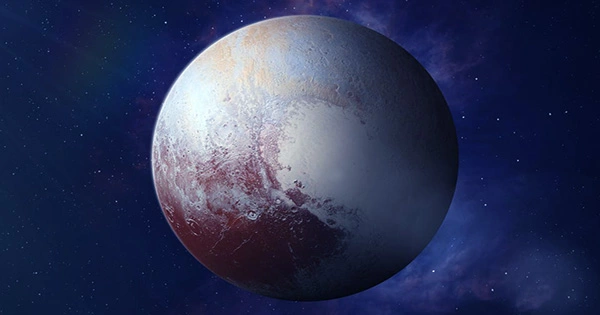On Saturday, NASA posted a beautiful image of Pluto’s real colors captured by its New Horizons mission on Instagram. The image, which was captured at a distance of 22,025 miles (35,445 km) from Pluto, also reveals the planet’s enormous glacier formed of nitrogen and methane, known as its “heart.” Pluto is thought to have a rocky interior and perhaps a subsurface ocean, while its surface is covered with ice composed of water, methane, and nitrogen.
According to NASA, Pluto’s surface is cratered, white, tan, and brownish-red in color. The partially visible “heart” is white, while the tan and white fall towards the top of the picture to reach the brown-red surface.
Pluto’s photograph was posted by the NASA agency with the comment, “Small planetary body Saturday? This photograph of Pluto, taken by our New Horizons spacecraft at a distance of 22,025 miles (35,445 km), captures the dwarf planet’s actual hues, as well as its “heart,” a glacier the size of Texas and Oklahoma comprised of nitrogen and methane.
The Kuiper Belt is thought to be full of tiny objects that are thought to have been left over from the formation of our solar system, and New Horizons, the first spacecraft to visit Pluto, is expected to explore this region. New Horizons is orbiting at a distance of 3.7 billion miles (5.9 billion km).
Previously ranked as the ninth planet in the solar system, Pluto was downgraded to the status of a dwarf planet in 2006. Pluto was downgraded to a dwarf planet by the International Astronomical Union (IAU) because it did not meet the three requirements for a full-sized planet. A celestial body in direct orbit around the Sun that is big enough that gravity forces rather than mechanical factors govern its structure is referred to as a “dwarf planet” by the International Astronomical Union (IAU).
Approximately half the width of the United States or two-thirds the width of the Moon, Pluto is slightly over 1,400 miles (2250 km) wide. Pluto is thought to have a rocky core and may even have a deep ocean, with an average temperature of -387F (-232C). Pluto’s surface is covered in ice consisting of water, methane, and nitrogen.
According to Space.Com, a sizable heart-shaped region informally called Tombaugh Regio is another distinctive feature on Pluto’s surface. Carbon monoxide ice has covered the left side of the area, which has the appearance of an ice cream cone. Within Pluto’s “heart,” more differences in the surface materials’ composition have been found.
















